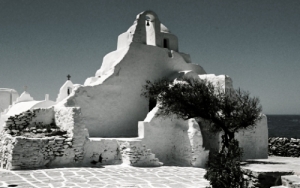 |
| The Church of Panagia Paraportiani in Mykonos Greece |
Churches and Cathedrals are not just places of prayer and worship; Churches are visible geographical writings of Christian History, off course written with Bricks and Mortar. Start listening to the Churches, what they have to say, you will understand the past, present and future of Christianity. World Churches is in effort to place Christian Architecture in front of you, so that you can understand Christianity better.
Monday, 31 December 2012
Unique Churches - The Church of Panagia Paraportiani in Mykonos Greece, Cyclades
The Church of Panagia Paraportiani in Mykonos Greece, Cyclades: The lovely church of Panagia (Virgin Mary) Paraportiani is among the most photographed churches in Mykonos.
The Panagia Paraportiani (Our Lady of the Postern Gate) is the most famous of the many churches on Mykonos. The sloping, whitewashed conglomeration of four chapels mixes Byzantine and vernacular architecture. Its position on a promontory facing the sea sets off the unique architecture. It is located at the entrance of Kastro neighborhood, right next to the sea. Its name Paraportiani actually
means "standing next to the entrance door", meaning that the church was
next to the Castle door. The building of this church started in 1425
and was not completed until the 17th century. The special thing about
this church is that it actually consists of five small churches that were built one on top or next to the other. The church of Agios Efstathiosis the centre of this complex, surrounded by the churches of Agios Anargyros, Agios Sozon and Agia Anastasia. On top of these four churches, there is the Church of Virgin Mary, which looks like a dome. The five churches were not constructed at once, but gradually along centuries. The oldest church is Agios Anargyros, which was built in late 14th century. The other churches were built in the 16th and the 17th century.
Famous Churches - The Church of Our Savior on Spilled Blood" (Spas na Kravi) at St Petersburg, Russia
The Church of Our Savior on Spilled Blood" (known locally as Spas na Kravi) is a spectacular Russian-style church that was built on the spot where Emperor Alexander II was assassinated in March 1881.
After assuming power in 1855 in the wake of Russia’s devastating defeat in the Crimean war against Britain, France and Turkey, Alexander II initiated a number of reforms. During the second half of his reign Alexander II
grew cautious of the dangers of his system of reforms, having only
barely survived a series of attempts on his life, including an explosion
in the Winter Palace and the derailment of a train. Alexander II was finally assassinated in 1881 by a group of revolutionaries, who threw a bomb at his royal carriage. architects were invited to submit plans for the building of this permanent monument and the definitive designs of Alfred Parland (1842-1920), were accepted after he won the competition set up by Alexander III, which stipulated that it had to be in the 'purely Russian style of the 17th century'. The foundation stone was laid in 1883 and it took nearly a quarter of a century to complete. With its distinctive cupolas the Muscovy design is unique in St. Petersburg and provides a dramatic contrast to the Neo-Classical Architecture which dominates the city center. Amongst this colorful exterior are 20 granite plaques recording the historic events of Alexander II's reign.
Inside there is almost 7,000 sq. meters of Italian marble and over 20 different Russian minerals, embellished with opulent mosaics based on paintings by Nikolai Bruni, Mikhail Nesterov, Viktor (Vassili) Vasnetsov, Andrei Ryabushkin and other religious artists of the late 19th century. Christ and the Apostles are portrayed within the cupola, whilst the walls and pillars are totally adorned with other Biblical scenes or images of saints. Mosaics
fill the niches, crevices and cornices and no surface is left bare of
ornamentation. The highest steeple is 81m (265 ft) high and the bell
tower seen on the left has 144 individual mosaic coats of arms. These
represent provinces, cities and towns of the Russian empire and were intended to reflect the nation's grief after the murder of their Tsar. Lenin originally
wished to demolish this monument to Tsardom until it was suggested that
because large buildings were scarce, it would serve well as a
warehouse. Bolsheviks proposed number of times to demolish this
increasingly popular monument to Christianity, but God Saved this Marvelous Church.
 |
| The Church of Our Savior on Spilled Blood, (Spas na Kravi), St. Petersburg, Russia |
 |
| Interior- The Church of Our Savior on Spilled Blood, (Spas na Kravi) |
Famous Churches -The Basilica di Santa Croce (Basilica of the Holy Cross), Florence, Italy
 |
| The Basilica di Santa Croce (Basilica of the Holy Cross),Florence |
 |
| Interior - The Basilica di Santa Croce, Florence |
Related articles
- Top Stops in Florence (foxnews.com)
Famous Churches - The Basilica of Our Lady of Guadalupe, Mexico City
 |
| Old The Basilica of Our Lady of Guadalupe, Mexico City |
Legend
According to the legend, Juan Diego was walking between his village and Mexico City on December 12, 1531 when Our Lady of Guadalupe appeared, speaking to him in his native Nahuatl language. She told him to build a church at the site. When Juan Diego spoke to the Spanish bishop, the bishop did not believe him, asking for a miraculous sign to prove his vision's authenticity. The Virgin appeared to Juan Deigo again and, although it was winter, told him to gather flowers.
 |
| Our Lady of Guadalupe |
The original miraculous apron containing the image of the Virgin hangs behind bullet-proof glass above the altar in the new basilica. The basilica now houses a museum of ex-votos (hand-painted depictions of miracles, dedicated to Mary or a saint in gratitude) and popular religious art, paintings, sculpture, and decorative and applied arts from the 15th through 18th centuries.
The present church was constructed on the site of an earlier 16th-century church that was finished in 1709, the Old Basilica. When this basilica became dangerous due to the sinking of its foundations, a modern structure called the New Basilica was built next to it; the original image of the Virgin of Guadalupe is now housed in this New Basilica.
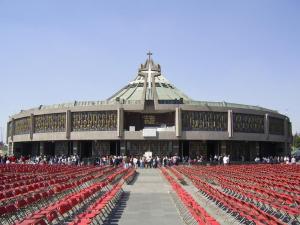 |
| New Basilica of Our Lady of Guadalupe, Mexico |
To the sides are the chapels of the Santisimo and of Saint Joseph. It has 9 chapels on the upper floor. Under the main floor are the Basilica's crypts, with 15,000 niches and 10 chapels. Its seven front doors are an insinuation to the seven gates of Celestial Jerusalem referred to by Christ.
Famous Churches - The Basilica at Eztergom, Hungary
The small town of Esztergom sitting on the bank of River Danube in Hungary played an important role in the establishment of the Hungarian state1000 years ago.
The building of The Basilica at Eztergom, Hungary is constructed on the foundation of several earlier churches. The first was built by Stephen I of Hungary. Saint Stephen I was Grand Prince and the First King of Hungary. He greatly expanded Hungarian control over the Carpathian Basin during his lifetime, broadly established Christianity in the region. The Original Saint Adalbert Church was constructed in 1001–1010, as the First Cathedral in Hungary and was burned down at the end of XII century. It was rebuilt, and even survived the Mongol invasion of Hungary. However, in 1304, Wenceslaus III, a probable candidate for the Hungarian throne, sacked the castle and the church. It was repaired in the following years.
The archbishops of the XIV and XV century decorated and improved the church, made alterations and added a huge library (The second most significant one in the country). It was ruined again under Turkish rule, in 1543. In 1820, the Archdiocese was restored and Archbishop Sándor Rudnay decided to restore status as mother church of the country. The architect was Pál Kühnel , the lead contractor was János Packh. The foundation-stone was laid and work began in 1822 and the final completion of The Basilica at Eztergom took place twelve years later in 1869. It is the tallest building in Hungary and the 18th biggest church in the world. The Church maintains the relics of Catholic martyr and Saint Marko Krizin.
 |
| The Basilica at Eztergom, Hungary |
 |
| The Basilica at Eztergom, Hungary |
Famous Churches - The Cathedral of Seville, Andalusia, Spain
 |
| The Cathedral of Seville, Andalusia, Spain |
 |
| Interior - The Cathedral of Seville, Andalusia, Spain |
The total area covers 11,520 square meters. The lifetime's work of a single craftsman, Pierre Dancart, this is the ultimate masterpiece of the cathedral - the largest and richest altarpiece in the world and one of the finest examples of Gothic woodcarving anywhere. The cathedralwas completed in just over a century (1402-1506).
Inside the Cathedral of Seville you will be struck by the size and richness of this universe of stone, stained glass windows and wrought iron work. The lightness of the columns accentuates the height of this hall-church with five spaces and lateral chapels.
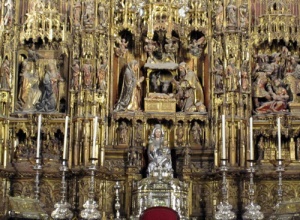 |
| Interior - Seville Cathedral |
Related articles
- Former Benghazi Catholic Cathedral - Later used as Arab Socialist Union Headquarter (planbox.wordpress.com)
Beautiful Churches - The Salt Lake Temple(Latter-day Saints) at Salt Lake City, Utah, USA
Wonderful granite structure of The Salt Lake LDS Temple was
constructed over a period of 40 years, from the laying of the
cornerstones on 6 April 1853 to the dedication on 6 April 1893.
The location for the temple was first marked by Brigham Young, the priest and second president of the church, on July 28, 1847, just four days after arriving in the Salt Lake Valley. The temple site was dedicated on February 14, 1853. Groundbreaking ceremonies were presided over by Brigham Young, who laid the cornerstone on April 6 of that year. The Salt Lake LDS Temple is the centerpiece of the 10-acre (4.0 ha) Temple Square in Salt Lake City, Utah.
The Salt Lake Temple took 40 years to build with its highly ornate
interior being completed in just a year. The walls of the Salt Lake
Temple are nine feet thick at the base and six feet thick at the top.
The Salt Lake Temple features beautiful hand-painted murals on the walls
of its progressive-style ordinance rooms: Creation Room, Garden Room,
World Room, Terrestrial Room (no murals), and Celestial Room (no murals). Rich symbolism adorns the exterior of The Salt Lake LDS Temple, depicting mankind's journey from mortality into the eternal realms.
 |
| The Salt Lake Temple, Utah, USA |
 |
| SLC Temple Assembly Hall |
- The Angel Moroni depicts both a messenger of the restoration of the gospel and a herald of the Second Coming: "for the Son of Man shall come, and he shall send his angels before him with the great sound of a trumpet, and they shall gather together the remainder of his elect from the four winds"( Revelation 14:6).
- The three towers on the east side represent the First Presidency of the Church and the Melchizedek Priesthood; the twelve pinnacles rising from the towers represent the Twelve Apostles. The three towers on the west side represent the Presiding Bishopric and the Aaronic Priesthood; the twelve pinnacles rising from the towers represent the High Council.
- The castle-like battlements that surround the temple symbolize a separation from the world as well as a protection of the holy ordinances practiced within its walls.
- The Earthstones, located at the base of each buttress, represent the earth—the "footstool of God."
- The moon is depicted in its various phases around the temple. The changing moon can represent the stages of human progression from birth to resurrection.
- The sunstones depict the sun—a symbol of the glory of the celestial kingdom.
- High above the sunstones on the east center tower are two clouds with descending rays of light. Once temples were dedicated in ancient Israel, they were filled with the "cloud of the Lord."
- Six-pointed stars represent the actual stars in the heaven. Upside-down five-pointed stars represent morning stars, compared to the "sons of God" in the scriptures. The large upright five-pointed stars may represent the governing power of the priesthood while the small upright five-pointed stars may represent the saving power of the priesthood for those who attach themselves to it.
- Located atop each of the center towers of the temple is the all-seeing eye of God, which represents God's ability to see all things.
Related articles
- 1870s LDS baptistry discovered on site of Provo City Center Temple (fox13now.com)
Sunday, 30 December 2012
Famous Churches - The Se Cathedral of Goa, India
 |
| The Se Cathedral in Goa, India |
The Se cathedral is one of the largest churches in Asia and it took eighty years to get completed. This cathedral was built to commemorate the victory of the Portuguese over a Muslim Army, leading to the capture of the city of Goa in 1510. The Se Cathedral of Goa is located in old Goa, and is around 9 kilometers from the capital city Panaji. The Se Cathedral of Goa is dedicated to St. Catherine of Alexandria. The actual construction began in 1562 under the reign of King Dom Sebastião and substantially completed by 1619. This magnificent edifice was built in the 16th century under the Portuguese rule in India. It was sanctified in 1640.
 |
| Interior of "The Se cathedral in Goa" |
The exterior of the church is constructed in the Tuscan style while the interiors have been constructed in the Corinthian style. The length of the church is 250 feet and the breadth is 181 feet. The entrance of the church is ornately decorated and measures around 115 feet in height. The church is famous for its giant bell known as the "Golden Bell".
In the interiors are placed six altars in the transverse part of the Cruciform of the church, three on either side of the main altar. To the right are those of St. Anna, Our Lady of Doloures and St. Peter and on left are those of Our Lady of Sorrows, Our lady of Three Necessities and Our Lady of Hope. The arches of four of these chapels are adorned with paintings depicting scenes from the life of saints.
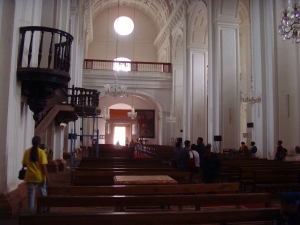 |
| Interior of "The Se Cathedral in Goa" |
Famous Churches - The church of St. Anne of Goa, India
The Legend
In 1577, the villagers who were living in Talaulim in Goa purchased a plot of land on which a small monastery was to be built to ease the process of conversion. Though the monasterywas constructed, it was not dedicated to any saint.
One
day a man reported an incident in which he had a vision of a woman
walking down the hill with a cane and a hat and claimed that the
monastery was her abode. At the same time, a Brahmin woman claimed that a similar woman had held her hand in her dream when she was very sick thus miraculously curing her. The woman had told her that her name was Anna and she wanted to reside in the monastery. The Brahmin lady graciously converted to Christianity following the miraculous cure. The whole village was stunned and the priest decided to sanctify the church in the name of St. Anne. This is how the church came to be known as The Saint Anne church.
The Church
The church of St. Anne of Goa is famous for its remarkable architecture in India. It is an example of baroque architecture in Goa.
The Church of St Anne is situated on the right bank of the Siridao River.The present church was reconstructed by Mons Francisco do Rego with his own money. Due to some unforeseen circumstances, he could not complete the construction and Father Antonio Francisco da Cunha was bestowed with the responsibility of completing the construction of the church. The church was finally completed in 1965. Regally nestled in the lush hills of Santana, Talaulim, the Church of Anne was declared a "national monument" during the Portuguese era. Upon Goa's annexation by India, the aforementioned structure was embraced as "national monuments" by the Archaeological Survey of India (ASI).
In 1577, the villagers who were living in Talaulim in Goa purchased a plot of land on which a small monastery was to be built to ease the process of conversion. Though the monasterywas constructed, it was not dedicated to any saint.
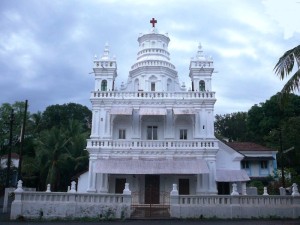 |
| The church of St. Anne of Goa, India |
The Church
 |
| Interior - The church of St. Anne of Goa, India |
The Church of St Anne is situated on the right bank of the Siridao River.The present church was reconstructed by Mons Francisco do Rego with his own money. Due to some unforeseen circumstances, he could not complete the construction and Father Antonio Francisco da Cunha was bestowed with the responsibility of completing the construction of the church. The church was finally completed in 1965. Regally nestled in the lush hills of Santana, Talaulim, the Church of Anne was declared a "national monument" during the Portuguese era. Upon Goa's annexation by India, the aforementioned structure was embraced as "national monuments" by the Archaeological Survey of India (ASI).
Beautiful Churches - The Crystal Cathedral, Garden Grove, Orange County , USA
The Crystal Cathedral was a pure show biz, from its movie star guest speakers to its artful use of the power of TV. The largest glass building in the world, The Cathedral was built by the Rev. Robert Schuller.
The building, designed by architect Philip Johnson, was completed in 1981 and seats 2,736 people. Schuller started out in 1955, as pastor of California's first "drive-in" church, in Garden Grove. It was actually situated in an old drive-in movie theatre, Schuller preached from the roof of the concession stand. After significant success on the airwaves, Rev. Schuller opened the Crystal Cathedral in 1980. Each week, the Sunday services at The Crystal Cathedral were broadcast live across the nation as "The Hour of Power," and they often featured Hollywood stars. The Crystal Cathedral’s pipe organ with 16,000 pipes is among the five largest pipe organs in the world, the Hour of Power Choir
with 100-plus voices is also an interesting feature and the electric
fountain/stream that runs down the middle of the central aisle is also
worth mentioning. The mammoth church is indeed impressive, made almost entirely of glass and a spider web framework of white steel, the star-shaped "cathedral"
is something extra ordinary. Over 400 feet long and 200 feet across,
raising some 12 stories above the ground, with an angular, mirror-like
exterior, its transparent, sun-lit interior features a giant television
screen, and an altar of rich marble. The Crystal Cathedral can accommodate about 3,000 worshipers for Sunday services. Giant, sliding glass doors on the side of the church allow even more worshipers to watch the services from their cars in the parking lot. The new glass tower
was added in 1990, is a stunning structure in its own right; at the
tower's base you will find a tiny, dome-shaped chapel housing an
uncommon, cross-shaped crystal. Having over 12,000 glass panes and a
sparkling, modern-day bell tower, The Crystal Cathedral is an Orange County landmark visible for miles around.
The Roman Catholic Diocese of Orange negotiated a pretty sweet deal when it purchased the iconic Crystal Cathedral, the longtime pulpit of the Rev. Robert H. Schuller and backdrop to his popular "Hour of Power" television broadcasts. Not only did Catholics get a national landmark designed by the renowned architect Philip Johnson, but Bishop Tod D. Brown wasn't even the highest bidder: Schuller and the board of the proudly Protestant mega church, opted to take Brown's $57.5 million offer over a $59 million pitch from Chapman University because the bishop would keep the campus as a place of worship.
 |
| The Crystal Cathedral, Garden Grove, Orange County , USA |
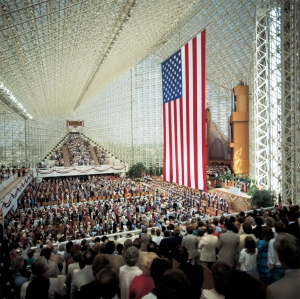 |
| Interior - The Crystal Cathedral, Orange County |
Unique Churches - Santuario della Madonna delle Lacrime"Our Lady of Tears" in Siracusa, Sicily
 |
| Santuario della Madonna delle Lacrime in Siracusa, Sicily |
On 29 August 1953, a small plaster image of the Virgin Mary in the house of Angelo Iannuso and Antonina Giusto suddenly began to shed tears. The following days, on 30 and 31 August and on 1 September, tears were seen again on the Virgin’s face.
The cavernous space was designed to house the image which reportedly bestowed 300+ miraculous cures over a few months after the tears.
The Church
Modeled on the shape of a tear drop, Syracuse's newest landmark building, it opened in 1994 and reaches a height of 102m. The "Our Lady of Tears" sanctuary is one of the most peculiar monuments or churches in all of Sicily. Designed to evoke a gigantic teardrop, the structure was created by two Frenchmen, Michel Arnault and Pierre Parat, in 1994. It houses a statue of the Madonna that supposedly wept for 5 days in 1953. So-called chemical tests showed that the liquid was similar to that of human tears. Pilgrims still flock here.
 |
| Santuario della Madonna delle Lacrime in Siracusa, Sicily |
Famous Churches - La Catedral de San Cristóbal, Old Havana, Cuba
 |
| Plaza de la Catedral de San Cristobal de La Habana Cuba |
 |
| Interior - Plaza de la Catedral de San Cristobal de La Habana Cuba |
Related articles
- Salta Cathedral, Argentina (planbox.wordpress.com)
- Catholic prayer fills the Crystal Cathedral (patheos.com)
Thursday, 27 December 2012
Mega Churches - Abundant Living Faith Center, El Paso, Texas
 |
| Abundant Living Faith Center, El Paso, Texas |
 |
| Abundant Living Faith Center, El Paso, Texas |
Sacred Places - The Orthodox Monastery of St Catherine at foot of Mount Horeb, Eygpt
Background
Ascetic monasticism in remote areas prevailed in the early Christian church and resulted in the establishment of monastic communities in remote places. St Catherine's Monastery
is one of the earliest of these, and the oldest to have survived
intact, having been used for its initial function without interruption
since the 6th century. In the early 4th century, St. Helena, mother of Constantine I, the Great, built the Chapel of the Burning Bush at the site where Moses is supposed to have seen the Miracle of the Burning Bush. The Orthodox Monastery of St Catherine stands at the foot of Mount Horeb where, the Old Testament records, Moses received the Tablets of the Law (Ten Commandments). The mountain is known and revered by Muslims as Jebel Musa. The entire area is sacred to three world religions: Christianity, Islam and Judaism. , St Catherine's Monastery founded in the 6th century is the oldest Christian monastery still in use for its initial function.
The Legend
The monastery is associated with St. Catherine of Alexandria, who was a Christian Martyr. Originally sentenced to die on the wheel, she didn’t die and was beheaded instead. According to legend, St. Catherine’s body was carried to the site of the monastery by angels. A Sinai monk once had a vision of her body at the top of a nearby mountain named Mount Catherine which is the highest summit in Sinai, where her remains were discovered. It’s said that monks found her remains in 800 AD.
The Monastery
The architecture of St Catherine's Monastery,
the artistic treasures that it houses, and its domestic integration
into a rugged landscape combine to make it an outstanding example of
human creative genius. It demonstrates an intimate relationship between natural grandeur and spiritual commitment. Its walls and buildings of great significance to studies of Byzantine architecture and the Monastery houses outstanding collections of early Christian manuscripts and icons.
The rugged mountainous landscape, containing numerous archaeological
and religious sites and monuments, forms a perfect backdrop to the Monastery. St. Catherine's is also a formidable fortification, with granite walls 40 to 200 feet tall, surrounded by gardens and cypresses. Prior to probably the 20th century, the only entrance to St. Catherine's
was a small door 30 feet high, where provisions and people where lifted
with a system of pulleys, and where food was often lowered to nomads.
It is a impressive natural setting for priceless works of art, including a wonderful Byzantine mosaic dating back to the 6th century, Arab
mosaics, Greek and Russian icons, Western oil paintings, paintings on
wax, fine sacerdotal ornaments, marbles, enamels, chalices, reliquaries, including one donated by Czar Alexander II in the 19th century, and another by Empress Catherine of Russia in the 17th century. But of perhaps even greater significance is that it has the second largest collection of illuminated manuscripts after Vatican. The collection consists of some 3,500 volumes in Greek, Coptic, Arabic, Armenian, Hebrew, Slavic, Syriac, Georgian and other languages. In 1844, A German Scholar visiting the library discovered and then arguably stole The Codex Sinaiticus, an extremely important 4th century version of the Bible that now rests in the British Museum in London. The Monastery even has a small 10th or 11th century Fatimid Mosque which was probably built to appease the Islamic authorities of the time. There is also a small chapel “The Chapel of St. Triphone”, also known as ”The Skull House”, which houses the skulls of deceased monks.
 |
| St. Catherine's Monastery, Eygpt |
The Legend
The monastery is associated with St. Catherine of Alexandria, who was a Christian Martyr. Originally sentenced to die on the wheel, she didn’t die and was beheaded instead. According to legend, St. Catherine’s body was carried to the site of the monastery by angels. A Sinai monk once had a vision of her body at the top of a nearby mountain named Mount Catherine which is the highest summit in Sinai, where her remains were discovered. It’s said that monks found her remains in 800 AD.
The Monastery
 |
| The Burning Bush in St Catherine's |
Historical Churches - St. Antony's Monastery (Deir Mar Antonios)at foot of Al-Qalzam Mountain near Al Zaafarana, Egypt
St. Antony
St Antony, son of well-to-do parents, he was orphaned at the age of 18 and upon hearing the Words of the Gospel, he gave all his possessions to the poor and placed his younger sister in a house for virgins, and sought to live a solitary life with God. His fame spread not only throughout Egypt and throughout the Roman Empire, many scholars, philosophers and emperors, including Emperor Constantine and his sons. St Antony died at the age of 105 on Mount Colzim; the site of the present day Monastery of St Antony the Great, a community was formed shortly after the saint’s death in memory of him. St Antony feast day is celebrated in the Coptic Church on 30 January, which corresponds to 22 Tuba according to the Coptic calendar. His life defined the nature of monastic spirituality and became the model for all subsequent forms of ascetic life. St. Antony's Cave (magharah), where he lived as a solitary person, is a 2 km hike from the monastery and 680 m. above the Red Sea. It offers stunning views of the mountains and the sea.
St. Antony's Monastery
St. Antony's Monastery (Deir Mar Antonios), and its neighbor St. Paul's, are both Coptic Christian and are the oldest inhabited monasteries in Egypt. Hidden deep in the Red Sea Mountains and relying on springs for their water supply, both still observe rituals that have hardly changed in 16 centuries. St. Antony's Monastery, which lies at the foot of Al-Qalzam Mountain near Al Zaafarana, was founded in 356 AD just after the saint’s death and is the oldest active monastery in the world. St. Antony
founded several monasteries during his life but they do not exist
anymore. During the sixth and seventh centuries, many monks from Wadi Natroun were under frequent attacks by Bedouins and they migrated to St. Antony's.
This monastery was plundered on many occasions and was also partly
destroyed in the 11th century. Between the 12th and 15th centuries, the
monastery flourished but was plundered again in 1454 by Bedouin servants. Due to such attacks, this is a fortress style monastery. Though Coptic today, over its many years the monastery was often multi-faith, housing monks of several different Christian Denominations. The Monastery
has exceptional wall paintings of holy knights in bright colors and the
hermit founders of the monastery in subdued colors and icons. These wall paintings,
widely know to monks and art historians, were obscured by soot, candle
grease, oil and dust, but recently, in a collaborated effort between the
Supreme Council of Antiquities and the American Research Center in Egypt, these unique painting were restored.
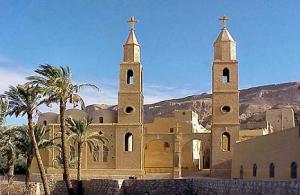 |
| The Coptic Monastery of Saint Anthony in Egypt |
St. Antony's Monastery
 |
| The Coptic Monastery of Saint Anthony in Egypt |
Related articles
- Egypt's Coptic church chooses new pope in ceremony (foxnews.com)
- Egypt's Copts to vote for Pope (bbc.co.uk)
Historical Churches - Kisha Shën Mëri Vllaherna (Church of Saint Mary of Vllaherna),Berat, Albania
 |
| Kisha Shën Mëri Vllaherna (Church of Saint Mary of Vllaherna) |
Historical Churches - The Church of the Assumption of the Virgin Mary, Bled Island, Slovenia
The Legend
According the Legend has it that on this place once stood a shrine of the Ancient Slavonic goddess Živa and was burnt down during the Christian war against the pagans. Priest Staroslav and his daughter Bogomila guarded it when Črtomir came to the island. The temple was destroyed during battles between the followers of the Pagan Cult and Christians, who destroyed the altar and built a church. Bogomila stayed in the new church with her father, while Črtomir, after his baptism near the Savica waterfall, went to Aquilea and became a missionary of the Aquilean patriarch among Slovenes. The bell has its own tale as well. It sank to the bottom of the lake during its transport to the island. Later on, the Pope
sent a new bell for the church. To commemorate this event, the locals
annually organize a symbolic pulling-the-bell-out -of-the -water.
Visitors can chime the Wish Bell in order for their wishes to come true. On the Bled Island, archeologists have discovered traces of prehistoric (11th to 8th centuries B.C.) and Slavic (9th to 10th century) settlements. 124 graves with skeletons from the 9th to the 11th century were found.
The Church
The Church of the Assumption of the Virgin Mary, Bled Island, Slovenia located on the island surrounded by the lake, presents the most recognizable icon at Bled Island. The first masonry church on the island, a three-naved Romanesque basilica, was consecrated by the Aquilean patriarch Pellegrino in 1142. In the 15th century, it was rebuilt in the Gothic style: a new presbytery, a freestanding bell tower and the main altar were built. The renovated single-nave church was consecrated in 1465 by the first Bishop of Ljubljana, Count Žiga Lamberg. In 1509 it was so damaged by an earthquake that it required thorough renovation, and this was carried out in the Baroque style. Only the frescoes in the presbytery and a wooden statue of the Virgin Mary, which probably adorned the main altar, are preserved from the previous Gothic Church. The church's present form is from the 17th century when it was renovated after another earthquake. The bell tower,
which was built in the 15th century, has been renovated several times
due to damage by two earthquakes, and in 1688 it was struck by
lightning. The present tower is 54 m high and has three bells.
 |
| The Church of the Assumption of the Virgin Mary, Bled Island, Slovenia |
The Church
 |
| Lake Bled Island Church Altar |
Related articles
- Virgin Mary image found in piece of wood (fox13now.com)
- VIRGIN MARY: Malaysian church gets hospital window that drew crowds believing they saw Virgin Mary image (vancouverdesi.com)
Beautiful Churches - The Notre-Dame Basilica (Basilique Notre-Dame), Montreal
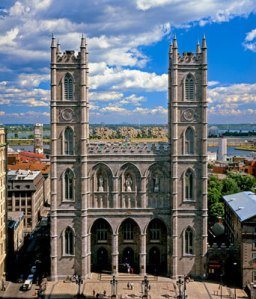 |
| Notre-Dame Basilica, Montreal |
 |
| Interior - Notre Dame Montreal |
Wednesday, 26 December 2012
Historical Churches - Santhome Cathedral at Mylapore,Chennai, India
St. Thomas Basilica is built over the tomb of Apostle St. Thomas. St. Thomas one of the twelve Apostles of Jesus Christ came to India in A.D.52, martyred in A.D.72 and was buried here in Mylapore.
There are only three basilicas built over the tomb of an apostle. St. Peter's at Rome and St. Jame's at Spain (Compestella, Santiago) are the other two. There is an underground tomb chapel below the Basilica of St. Thomas who brought Christianity to India is considered to be the Father of Indian Christianity’ here pilgrims can pray in front of the Sepulcher of St. Thomas. People believe that sand taken from the tomb has Miraculous Healing Powers. The church has made a Beautiful Credit Card for pilgrims, the St. Thomas Card, with a little of the St. Thomas
sand embedded in it. This can be carried around like a normal credit
card in a wallet or purse. Renovated in the early 1970s, this Basilica
draws huge crowds. There is a beautiful stained glass window at The Basilica, which portrays the story of St. Thomas and the central hall has 14 wooden plaques depicting scenes from the last days of Christ. In The Cathedral is a 3ft. high statue of Virgin Mary, which was brought from Portugal in 1543. The official residence of the Archbishop of the Madras, Mylapore Archdiocese is in Santhome adjacent to The Basilica.
 |
| Santhome Cathedral, Mylapore,Chennai, India |
Historical Churches - The Sanctuary of Our Lady of Fátima in Fátima, Portugal
The Legend.
The small town of Fatima, 88 miles (140km) North of Lisbon, is one of the world’s most important holy sites.
In 1917 the Virgin Mary appeared here to Three Shepherd Children and in 1930. Between May and October 1917, Our Lady appeared six times to three young Portuguese children in a field called the Cova de Iria,
near the small village of Fatima, about seventy miles north of Lisbon.
The children who received the apparitions had been brought up in an
atmosphere of piety. They were Lucia dos Santos, aged ten, and her two younger cousins Francisco and Jacinta. They tended sheep together and often would kneel in the open field to pray the Rosary.On the day of the final apparition, October 13, 1917, she identified herself as "Our Lady of the Rosary"
and the dramatic episode of the dance of the sun took place, witnessed
by a crowd of seventy-thousand people, in which the sun seemed to tumble
from the sky. The Catholic Church officially recognized these visions and The Basilica of Our Lady of the Rosary was built.
The Church
The first structure of The Sanctuary of Our Lady of Fátima in Fátima, Portugal was built on the location of the apparitions was a small archway which was soon replaced by a tiny chapel over the spot of the apparitions.
First chapel was destroyed by dynamite in 1922, a second chapel was built. The foundation stone for The Basilica of Our Lady of the Rosary was laid on October 13, 1928 and the finished structure was solemnly consecrated on October 6, 1953. This Neoclassical Church can hold 300,000 persons inside. Those who are dressed properly are permitted entrance. Two of the three children who first saw the vision are buried here.
The small town of Fatima, 88 miles (140km) North of Lisbon, is one of the world’s most important holy sites.
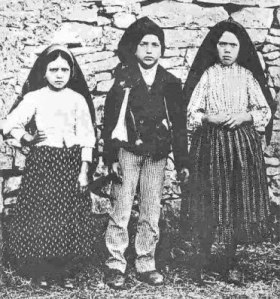 |
| The Sanctuary of Our Lady of Fátima in Fátima, Portugal |
The Church
The first structure of The Sanctuary of Our Lady of Fátima in Fátima, Portugal was built on the location of the apparitions was a small archway which was soon replaced by a tiny chapel over the spot of the apparitions.
First chapel was destroyed by dynamite in 1922, a second chapel was built. The foundation stone for The Basilica of Our Lady of the Rosary was laid on October 13, 1928 and the finished structure was solemnly consecrated on October 6, 1953. This Neoclassical Church can hold 300,000 persons inside. Those who are dressed properly are permitted entrance. Two of the three children who first saw the vision are buried here.
Modern Churches - The Igreja da Santíssima Trindade (Church of the Holy Trinity)
At the Fatima Sanctuary, North of the Portuguese Capital Lisbon, lies one of the most important shrines of the world dedicated to the Virgin Mary, The Igreja da Santíssima Trindade (Church of the Holy Trinity).
Ranked as the Fourth Largest Christian Church in the World, the low, oval, white building accommodates nearly 9,000 worshipers. the church was constructed between 2004 and 2007, A Greek named Alexandros Tombazis was the Architect of the Church. The first stone was laid on June 6, 2004; it was a piece of marble taken from the Tomb of Apostle Peter, over which St Peter's Basilica in Rome was built. The Igreja da Santíssima Trindade (Church of the Holy Trinity) was consecrated on October 12, 2007, on the occasion of the 90th anniversary of the Apparitions of Fátima.
 |
| The Igreja da Santíssima Trindade (Church of the Holy Trinity) |
Beautiful Churches - The Basilica of Our Lady of Peace (Basilique de Notre Dame de la Paix de Yamoussoukro) in Yamoussoukro, Ivory Coast
The Ivory Coast (Cote d'Ivoire)
has only 20-30% Christians, with the remainder adhering to indigenous
animist religions (25-40%) and Islam (35-40%). Located in the West African bush,
The Basilica of Our Lady of Peace (Basilique de Notre Dame de la Paix de Yamoussoukro) in Yamoussoukro is one of the Largest Church in The World. Côte d'Ivoire president Félix Houphouët-Boigny chose his birthplace of Yamoussoukro
as the new capital of his country in 1983. As part of the plan for the
city, the president wished to memorialize himself with the construction
of what would be the "Greatest Church in the World."
The president commissioned a stained glass window of his image to be
placed beside a gallery of stained glass of Jesus and the apostles. The
basilica was constructed between 1985 and 1989, it was intentionally modeled after the Basilica of Saint Peter in Rome, whose size it intentionally surpassed to become the largest church in the world. The cornerstone was laid on August 10, 1985, and was consecrated on September 10, 1990. Architect Pierre Fakhoury constructed the dome to be slightly lower and the cross on top to be larger.
It
is a remarkably beautiful building. The finished height is 158 meters
(518 feet). There is enough space to seat 7,000 people in the nave with
standing room for an additional 11,000 people. The Basilica is constructed with marble imported from Italy and is furnished with 7,000 square meters of contemporary stained glass from France.
Columns are plentiful throughout the basilica but are not uniform in
style. Next to the basilica are two identical buildings serving as a rectory and private papal villa, respectively.
 |
| Basilique de Notre Dame de la Paix de Yamoussoukro, Ivory Coast |
 |
| Basilique de Notre Dame de la Paix de Yamoussoukro, Ivory Coast |
Historical Churches - Church of St. Gregory the Great at Kercem, Malta
 |
| Church of St. Gregory the Great at Kercem |
Modern Churches - The Church of the Gesù, Ateneo de Manila University, Philippine
 |
| The Church of the Gesù, Ateneo de Manila University, Philippines |
The Church of the Gesù is situated on Sacred Heart Hill, a small hill overlooking Bellarmine Field and believed to be the highest point in Loyola Heights. Designed by Jose Pedro Recio and Carmelo Casas, The Church of the Gesù is a landmark church of the Ateneo de Manila University campus in the Philippines. The structure’s massive triangle symbolizes the Holy Trinity, as well as the three fold mission and vision of the school. Its shape and design is also meant to suggest the outstretched arms of the Sacred Heart, and the traditional Filipino bahay kubo.
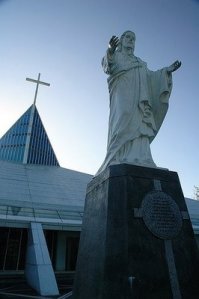 |
| Outstretched Arms of the Sacred Heart |
One side of the church houses a side chapel dedicated to Mary in the mystery of the Immaculate Conception, patroness of the Ateneo de Manila and of the Philippines, while another side chapel is dedicated to the Sacred Heart of Jesus, a devotion committed to the Jesuits by Jesus's appearances to Margaret Mary at Paray-le-Monial.
Subscribe to:
Posts (Atom)
